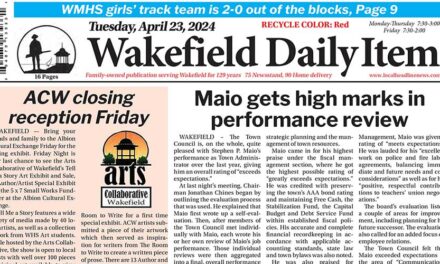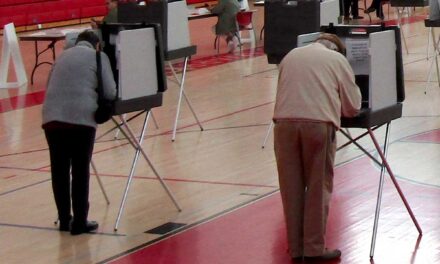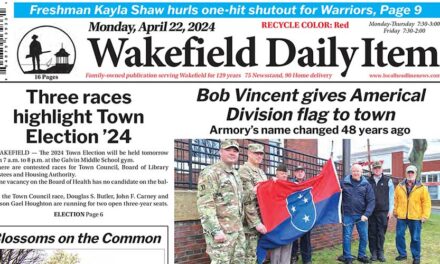Published in the May 25, 2016 edition

LOCAL ATTORNEY Mark Curley took this photograph outside the chapel at Arlington National Cemetery during his friend General John R. Galvin’s funeral last week.
Wakefield native and retired four star Army General John Rogers Galvin was laid to rest in Arlington National Cemetery on Thursday, May 12, and received the type of ceremony he both earned and deserved.
General Galvin, son of a Wakefield mason who rose to help oversee the end of the Cold War, died last Sept. 25.
Atty. Mark Curley, a longtime friend of the general’s, was at the service attended by a couple hundred people. Inside the chapel the audience, which included Galvin peer Gen. Colin Powell, listened to a eulogy given by Gen. David Petraeus, who at one time led the country’s military surge in Iraq.
After the service, Curley said the ceremony was just as impressive. Outside, between 750 and 1,000 soldiers from different branches of the Armed Forces lined up to honor General Galvin, whose casket was put on a caisson drawn by white horses and accompanied by a riderless horse with reversed black books in the saddle stirrups.
The general was given a 16 cannon salute. Bands played music and a rifle company offered a gun salute of its own.
Following is Petraeus’ eulogy for his longtime mentor and friend.
~
In 1992, President George H.W. Bush stated, “General Jack Galvin is one of the greatest soldiers this country ever had.” That was the assessment of our commander in chief shortly after General Galvin’s retirement. “One of the greatest soldiers … Ever.” I know that all here share that assessment.
We gather here this afternoon to recall and, indeed, to celebrate the life of that great soldier, Jack Galvin, a truly remarkable man, so special in so many ways to those of us assembled here today and to so many others, as well. And it is wonderful to see in the pews so many of Jack’s friends, classmates, admirers and former colleagues from his days in uniform, in academia and in the world of national security. I know that your presence means a great deal to Ginny, the Galvin girls, their spouses, the grandkids and Jack’s other relatives here this afternoon.
As most here know, Jack Galvin was the proud son of an Irish brick layer from Wakefield, Massachusetts — beloved Wakefield to him, a place to which he always returned with fondness and where the Galvin Middle School memorializes him in his hometown. He took pride in his roots and sought to revisit them frequently.
After high school, Jack tried his hand briefly at a few different career paths before finding his footing as an enlisted man in the National Guard, then as a cadet at West Point, and ultimately as a soldier and a leader of soldiers.
Highly decorated on the battlefield in Vietnam, where he was particularly respected as a courageous and courageously forthright battalion commander with the First Cav Division, Jack was a true student of his profession. He ultimately rose, of course, to the pinnacle of command as a Cold Warrior known for his clear thinking, unshakeable integrity, quiet determination, and straight forward assessments and advice. He was, unquestionably, a great soldier and an inspired, brilliant commander of hundreds of thousands, indeed, millions, of American and NATO Alliance men and women in uniform – a leader whose example, focus, thinking, and measured enthusiasm were truly inspirational.
In his final assignments in uniform, as a division commander in the newly formed Rapid Deployment Force, as the Commander of a Corps deployed along the inner-German border in Cold War Europe, as Commander in Chief of U.S. Southern Command when numerous insurgencies threatened Latin American countries, and then as NATO’s Supreme Allied Commander in Europe, Jack Galvin was a gifted, statesman, as well as a great soldier, as comfortable with presidents and prime ministers as he was with troopers in the field. These qualities were also clearly on display in his post-uniform position as a special envoy for the Balkans.
Jack Galvin was also a true scholar, author of four books and dozens of articles, a professor and later Distinguished Fellow at West Point, and ultimately the Dean of the Fletcher School of Law and Diplomacy at Tufts University, where he had once been a graduate student and where the Dean Jack Galvin Lecture Series has now been established. Indeed, it was a privilege for me to give the inaugural lecture in early February, during which I recalled the many extraordinary qualities of General and Dean Jack Galvin, together with one of the stellar faculty members from the Galvin days, Professor Dick Shultz.
Throughout the course of his career, Jack Galvin was called upon to make a number of recommendations and difficult decisions on issues with far reaching implications – on tactics and operations on the battlefield in Vietnam, advocating the establishment of an Aviation branch in our Army, supporting the provision of assistance to El Salvador, Columbia, Peru and other Latin American countries under siege by insurgents and narco-trafficantes, and supporting, with appropriate cautions, the intermediate nuclear force agreement between the U.S. and the USSR, noting the need to shore up NATO’s conventional forces to butress deterrence along the frontiers of freedom in Cold War Europe. Those are but a few examples among many. His judgment in each case was hugely impressive.
But, as he was always quick to observe, the best decision he ever made was to seek for his wife the lovely, wonderful Ginny Brennan, who was with him at every subsequent step of the way – not only raising their four exceptional daughters together, sharing their love with their daughters’ spouses and their children, but also serving as an exceptional first lady at a number of posts, and in that capacity, I should acknowledge, helping to guide and mentor General Galvin’s aides, special assistants, and others helping him discharge his duties – and even serving as our personal shopper on some trips to ensure that we never arrived home with empty arms for our loved ones. And, Ginny, you should know that we still have the colorful beach towels you got during a trip in Panama for me to give to Team Petraeus!
You should also know that whenever in need of a joke with an Irish-American audience, I will recall General Galvin asking Kathleen and Erin, “And what would you be, if ye weren’t Irish, my girls?” And they would smile sweetly and reply, “Ashamed.”
Reflecting on Jack Galvin reminds us that he was not just an incomparable soldier, a gifted statesmen, an exceptional scholar, and a wonderful husband and father. At the end of the day, Jack Galvin was also an extraordinary friend, mentor, and source of energy, encouragement, thoughtful advice, and example to those of us who had contact with him over the years. That is one reason why the pews here today are overflowing.
I am certain I am not alone in remembering the subtle, encouraging ways General Galvin shared his thoughts and ideas, and how he inspired the men and women he led to grow and to test their boundaries. He knew what it meant to be a leader, mentor, and friend – on the battlefield, in the barracks, in classrooms. For years, General Galvin and I had long conversations and exchanged dozens of letters – he was, of course, a prolific correspondent. We discussed many topics; but, inevitably, we returned to ideas about leadership and what it means to inspire and encourage others to achieve a common purpose. I drew on our discussions extensively during the times that I was privileged to lead our men and women in uniform during the wars of the post-9/11 decade.
Jack had a shorthand for one element of leadership. He called it the “Big M.” It had to do with a sense of mystique, of mythology, in which a leader takes on a slightly larger than life role and comes to represent what a team or an organization strives to achieve. Jack Galvin was the Big M, and it was a privilege to help him at various junctures to expand his influence, as he described what he wanted those around him to do. For what it’s worth, he called me the Little M – though he tried to pass the Big M mantle to me after the surge in Iraq. That initiative was rebuffed, for there was only one Big M.
I was privileged to serve directly for General Galvin in three assignments – first, as his aide when he was a division commander; then as a temporary duty special assistant when he was Commander in Chief of U.S. Southern Command; and finally, as a speechwriter in his first year as NATO’s Supreme Allied Commander. Even after that final assignment, our correspondence and conversations continued; as many in the pews here know first hand, once you had worked closely with General Galvin, you never truly stopped working for him. In truth, you didn’t want to. We all loved the interaction with the Big M. And it was a final privilege for me, ultimately, to write the foreword for his last book, his memoir.
In the first of our assignments together, we used to run together in the early mornings at Fort Stewart, Georgia, then the home of the 24th Infantry Division. Often we fell into the ranks with units out for their morning PT runs, setting the pace when we had a chance, calling a cadence that gave energy, inspiring those in the ranks to up their game, and inevitably making a reasonably considerable impression. There was not a tradition in those days of division commanders routinely running with their troopers, much less just joining them on the street, but General Galvin was different.
Joining a unit run was a small gesture by a significant figure, but it spoke volumes, as did General Galvin spending extensive time in motor pools, on ranges, and in the field with units, and not just during division exercises. This was a significant change for our division, and again, not common in our Army at the time. Through small gestures, small examples, these actions were an essential part of the way in which Jack Galvin engaged with those he led. And in all of it, he always sought to foster a style and a sense of belonging, of being a team. … It was through such actions and examples that Jack educated many rising leaders about what it meant to inspire and to encourage others. In turn, this also fed the Big M, and that enabled General Galvin to influence even more effectively the units he was privileged to lead and those who were privileged to have him as a leader.
Those of us who were touched by Jack Galvin, who were graced by the leader and man that he was, know that we are different because of that connection and better for the influence he had on us. For he was a truly extraordinary man, graceful in his humility, powerful in his insights, considerate in dealing with all.
Of course, the arc of General Galvin’s military career followed the rise and fall of a pivotal, contentious opposition of world powers through to a dramatic, somewhat unexpected outcome. “We were,” Jack wrote in his final book, “trying to act our parts on the stage while the stagehands changed the scenery around us.” Many of you were on that stage with him and recall the tense, difficult times that defined so much of Jack Galvin’s professional life.
All of this was captured beautifully in his memoir, and I applaud vigorously one more time all that Ginny, Kathleen, Bob Sorley, and a host of others did to help Jack finish and publish that wonderful book, so full of insights and stories. If you have had a chance to read or listen to it, you know that “Fighting the Cold War” is typical of the man – lacking in bravado, every inch the forthright, introspective soldier, and capturing the essence of his times with extraordinary nuance and thoughtful, penetrating observations about military and world leaders and the extraordinary challenges they faced together.
I am told that Jack had another “M,” a shorthand that meant “I miss you.” He included this as a postscript on his many letters to family, to his daughters an ocean away at college. A cartoonist from his earliest days, Jack invariably added a doodle to this “M,” turning it into a small, comical bird with unblinking eyes and rangy feet, alighting on the back of the envelope. “I miss you.” An insider signal. A shorthand, like so many others he captured on the always present 3×5” cards carried in his breast pocket.
Today, we recall how much we miss him – though we know, as we remember all that General Galvin did for so many over the years, how fortunate we were to have him – and the Galvin family – in our lives. Our country is better for it, we are better for it, and we are, in many respects, a team because of it. Inspired by the man, humbled by all that he accomplished, encouraged by his example and his many kind gestures – especially by the ways he connected with each of us and challenged us to be our very best. To be all that we could be.
At the end of the day, Jack Galvin was first — and always — a soldier. An Infantryman. Today he will be laid to rest among other soldiers, exactly where he would want to be — in the cemetery where he took countless walks, examining the statuary and the vistas, and taking an opportunity to reflect.
General Galvin particularly loved the statue in the cemetery of General Phil Kearny at Chantilly, early in the Civil War, one arm pinned to his chest, wheeling his horse after being hit while bravely reconnoitering the ground in advance of his division.
It is with that great soldier and many other soldiers, sailors, airmen, and marines that General Galvin will be laid to rest, watched over by the stone sentinels of Arlington. The Big M, resting in a familiar and beautiful place, his extraordinary life on earth complete – but still an inspirational figure to those of us privileged to have known and served with him. May he now rest in peace, as we reflect on the peace he helped achieve as a Cold Warrior. … Jack Galvin, “one of the greatest soldiers this country ever had.”
Thank you.




